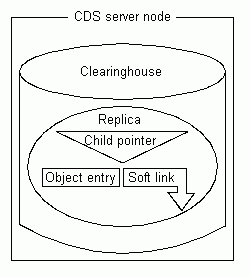Summary
To summarize, a cell consists of a complete set of names that are shared and managed by one or more CDS servers in a cell. A name can designate a directory, object entry, soft link, or child pointer. The logical representation of a cell's namespace is a hierarchical structure of directories and the names they contain. Every physical instance of a directory is called a replica. Names are physically stored in replicas, and replicas are stored in clearinghouses. Any node that contains a clearinghouse and runs CDS server software is a CDS server.
The following figure shows the components of a CDS server node. Every server manages at least one clearinghouse containing directory replicas. A replica can contain object entries, soft links, and child pointers. The figure shows only one replica and one of each type of entry that is possible in a replica. Normally, a clearinghouse contains many replicas, and a replica contains many entries.
Components of a CDS Server Node
